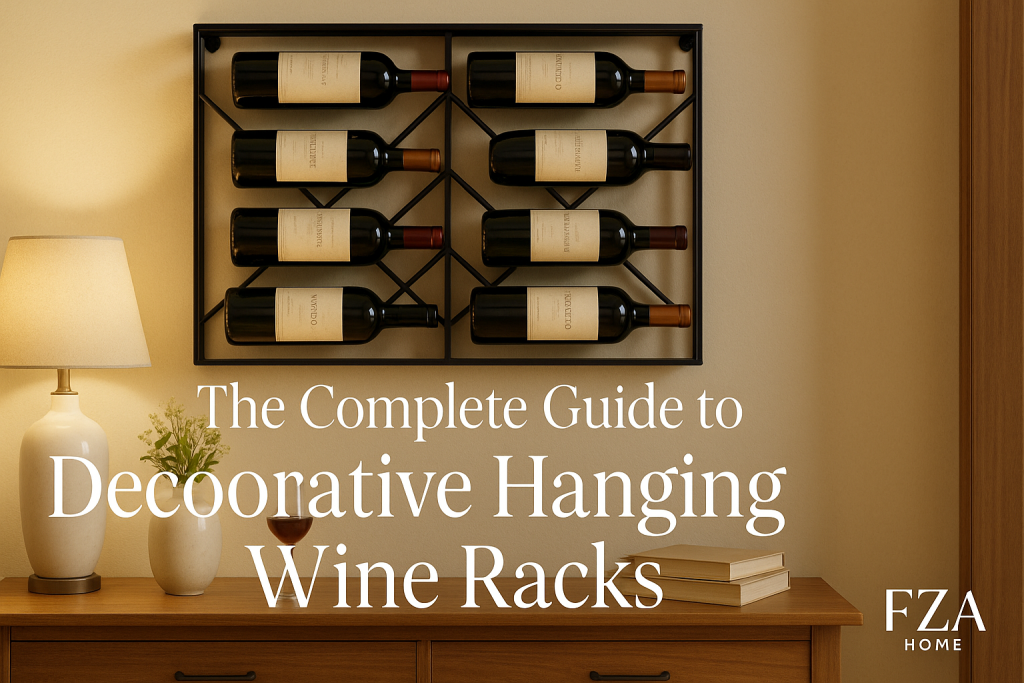
A decorative hanging wine rack is more than just a place to stash bottles—it’s a statement piece that brings personality, function, and a touch of flair to your home. Unlike traditional floor-standing units or bulky cabinets, hanging racks free up valuable storage space, elevate your décor, and put your favorite vintages on proud display. In this guide, we’ll dive into everything you need to know: from the basics of what a hanging wine rack is, to the many benefits these eye-catching fixtures offer, the various styles available, and the materials and finishes that make each design unique. By the end, you’ll know exactly which decorative hanging wine rack will become the perfect focal point—whether in your kitchen, dining room, bar nook, or even living area.
What Is a Hanging Wine Rack?
A hanging wine rack is exactly what it sounds like: a storage solution designed to suspend wine bottles (and sometimes stemware) from the wall, ceiling, or underside of cabinets. Rather than resting bottles horizontally on shelves, these racks cradle each bottle’s body or neck, using gravity to keep corks moist and wines properly aged. Many models also include slots or hooks for wine glasses, creating a compact all-in-one station for both storage and display. Because they hang, they transform underutilized vertical spaces—think blank walls or the underside of upper cabinetry—into elegant galleries of your favorite labels.
Why Choose a Hanging Design Over Traditional Storage
There are several compelling reasons to opt for a hanging wine rack instead of a floor or countertop model:
- Space Optimization: By moving bottles off counters and out of cabinets, you reclaim precious real estate for prep work or décor. Even in small kitchens or apartments, you can install a rack under a cabinet or above a breakfast bar.
- Visual Impact: Bottles suspended in mid-air create an immediate design focal point. Unlike plain shelves, hanging racks showcase the curves and colors of each bottle, turning your collection into art.
- Improved Air Circulation: Hanging designs often leave more open air around each bottle than a traditional rack, helping maintain consistent temperature and preventing moisture buildup.
- Ease of Installation: Many hanging racks come with simple brackets or hooks that require minimal tools—ideal for renters who want to personalize their space without major renovations.
Together, these advantages make hanging wine racks an attractive alternative for anyone looking to add a custom, decorative touch to their home bar or kitchen.
Benefits of Decorative Hanging Wine Racks
Space-Saving Advantages
Perhaps the most obvious benefit of a hanging wine rack is saving space. In smaller living quarters—like studio apartments or compact kitchens—floor racks can feel bulky and take up vital floor or counter space. Hanging racks utilize vertical real estate that would otherwise go unused. Installed under cabinets, above islands, or along empty walls, they store multiple bottles without crowding your work surface. Even a narrow under-cabinet rack can hold 4–6 bottles plus a few glasses, freeing up drawers and countertops for utensils, gadgets, or fresh ingredients.
Aesthetic Appeal and Visual Interest
Decorative hanging wine racks are available in an astonishing variety of shapes, finishes, and styles—from industrial metal grids to rustic wooden beams and sleek acrylic cradles. This versatility lets you match your rack to any décor theme: farmhouse chic, minimalist Scandinavian, ultra-modern, or coastal cottage. Plus, hanging your wine makes it a part of the room’s ambiance; the labels face outward like gallery art, catching the eye of guests and sparking conversation. Some designs even incorporate LED accent lighting to illuminate your collection from below or above, heightening the visual drama.
Ease of Access and Organization
A hanging rack’s open design means you can see every bottle at a glance—no more rummaging through a cabinet or peeking behind other bottles to find that special vintage. Many decorative racks feature staggered slots or cradles that angle each bottle slightly downward, ensuring the cork stays moist and the wine ages properly. Some also include integrated glass holders, allowing you to keep your stemware alongside your bottles for instant entertaining readiness. This combo of visibility and accessibility can streamline your hosting routine and make daily access to your favorite bottle effortless.
Types of Hanging Wine Racks
Wall-Mounted Racks
Wall-mounted racks attach directly to a vertical surface, offering a bold display that doubles as wall art. They range from simple single-row rails that hold bottles by the neck, to expansive grid systems that can store dozens of bottles in a geometric pattern. Installation usually involves anchoring screws or brackets into wall studs, ensuring stability. Wall racks work well in hallways, dining rooms, or open-concept living areas where you want to make a design statement.
Under-Cabinet Racks
Under-cabinet racks are perfect for kitchens and home bars. Mounted to the underside of upper cabinets or shelves, they tuck discreetly out of the way but keep bottles and glasses within easy reach. Many styles slide on simple metal brackets or hooks, making them easy to install—and removable if you move. Because these racks sit just above your countertop, they free up precious workspace below and streamline your pour-and-serve process.
Ceiling-Hung Racks
For a truly dramatic effect, ceiling-hung wine racks suspend from the ceiling, creating a floating canopy of bottles above your island or bar. These racks often use sturdy metal frames with crossbars or rails, supporting both bottles and glasses. While installation is more involved—requiring secure ceiling anchors or joist attachments—the result is a stunning centerpiece that draws the eye upward and gives your space a high-end, bespoke feel.
Over-the-Shelf and Cabinet-Door Racks
Innovative designs now allow you to hang wine storage directly off existing shelving or even the inside of cabinet doors. Over-the-shelf racks hook onto the top of a shelf, eliminating the need for drilling, while cabinet-door racks mount on hinges so they open and close with your doors. These options are ideal for renters or anyone who wants a no-drill solution that maximizes every inch of storage without permanent modifications.
Materials and Finishes
Wood: Rustic, Modern, and Reclaimed
Wood is a timeless choice for hanging wine racks, offering warmth and natural beauty. For a rustic look, reclaimed barnwood or distressed pine adds character and story. Modern designs often feature smooth maple or beech with clean lines and minimal hardware. Solid hardwoods like oak provide durability and can be stained in any hue—from pale driftwood to deep espresso. Wood racks integrate seamlessly into farmhouse, traditional, and transitional interiors.
### Metal: Industrial, Wrought Iron, and Stainless Steel
Metal racks convey an industrial or contemporary vibe. Wrought iron with ornamental scrollwork suits vintage or loft-style spaces, while sleek stainless steel fits ultra-modern kitchens. Powder-coated finishes in black, white, or bold colors add durability and allow you to match or contrast your cabinetry. Metal racks are tough, moisture-resistant, and easy to clean, making them a practical choice for humid environments like kitchens.
Acrylic and Glass Elements
For a light, airy look, acrylic and glass racks seem to float wine bottles in mid-air. Clear acrylic cradles can blend almost invisibly into any décor, letting your bottles—and their labels—take center stage. Tempered glass panels with integrated grooves offer a contemporary gallery effect, though these designs often pair best with metal framing for added support. Acrylic and glass work beautifully in minimalist and high-gloss modern interiors.
Mixed-Material Designs
Combining materials creates dynamic, personalized pieces. Imagine a walnut cradle with matte-black steel brackets, or a reclaimed-wood beam hung by polished copper rods. Mixed-material racks can balance warmth and edge, blending the organic feel of wood with the sleekness of metal or acrylic. These custom looks let you create a one-of-a-kind focal point that ties multiple design elements together in your space.
Styles and Decorative Themes
Minimalist and Scandinavian
Minimalist and Scandinavian designs embrace clean lines, neutral color palettes, and a “less is more” philosophy. In the context of a decorative hanging wine rack, this translates to sleek, unobtrusive forms that showcase your bottles without overwhelming the space. Think thin, powder-coated steel rails in matte black or white, or light-colored birch and ash wood cradles that almost disappear against a pale wall. The emphasis is on function: each bottle slot is precisely spaced, and any transitions between materials are seamless and understated. For a Scandinavian touch, pair your rack with simple geometric artwork, white cabinetry, and pops of natural textiles like linen or jute. The overall effect is an airy, tranquil corner that highlights the shapes and labels of your wine collection as subtle design accents.
Vintage and Farmhouse
For a cozier, more nostalgic vibe, vintage and farmhouse-themed hanging wine racks lean into rustic materials and artisanal craftsmanship. Reclaimed barnwood beams with hand-hammered iron hooks evoke a countryside cellar, while distressed finishes and visible joinery lend character and warmth. You might see details like decorative corbels, wrought-iron scrollwork, or even repurposed railway ties for true patina. To enhance the theme, surround your rack with antique wine barrels, wicker baskets, and enamelware pitchers. Soft Edison-style bulbs above help cast a warm glow, while mason jars or galvanized metal containers hold corks and bottle openers below. This style is perfect for kitchens or dining areas that emphasize comfort, handmade touches, and a lived-in look.
Industrial Chic
Industrial chic is all about raw materials, exposed hardware, and a slightly edgy feel. Hanging wine racks in this style often feature blackened steel, brushed aluminum, or polished copper tubing, paired with rough-hewn wood or concrete accents. The aesthetic borrows from loft-style architecture: think open ceilings, visible ductwork, and factory windows. Your wine rack could consist of minimalist metal grids suspended by heavy-duty cables or a scaffold-inspired frame bolted to the ceiling. Pair it with metal bar stools, concrete countertops, and Edison bulbs to complete the warehouse-to-home transformation. The result is a functional display that feels modern, urban, and a little bit hard-edged—perfect for contemporary lofts or man-cave bars.
Coastal and Nautical
Bring breezy seaside vibes into your home bar or kitchen with coastal-inspired hanging wine racks. Light, weathered woods like bleached oak or driftwood pairs beautifully with whitewashed walls and navy accents. Nautical rope loops, brass fittings, and porthole-style hooks add authentic maritime details. Some designs even incorporate recycled boat cleats or fishing net motifs. To reinforce the theme, display shells, coral accents, and maritime maps nearby. Soft LED strips can mimic the gentle glow of a lighthouse, illuminating your bottles at night. This style works well in beach houses or any space where you want to evoke a sense of oceanic relaxation and casual elegance.
How to Choose the Right Size and Capacity
Counting Your Collection: Bottles and Stemware
Begin by taking inventory of how many bottles you currently own—and consider how many you plan to accumulate in the next few years. A small rack that holds 6–8 bottles might suffice for casual drinkers, but serious oenophiles often need space for 20–30 or more bottles. Don’t forget stemware: racks that include integrated glass holders can free up cabinet space. Sketch out your ideal capacity, then factor in a buffer (usually 10–20%) to accommodate new purchases and gifts. This ensures you won’t outgrow your rack too quickly.
Measuring Available Space
Next, measure the exact area where you plan to install your hanging rack. Note the height, width, and depth available, then compare those dimensions to the rack’s specifications. For under-cabinet racks, ensure there’s enough clearance between the bottom of your cabinet and the countertop for the bottles and glasses you use most. Wall-mounted units should allow at least 4 inches of clearance behind each bottle for airflow and easy extraction. Always double-check that you’re not blocking light switches, outlets, or doorways. A well-measured installation area prevents surprises and ensures your rack fits both functionally and visually.
Single- vs. Multi-Bottle Configurations
Decide whether you prefer a single row—ideal for highlighting a small selection of favorites—or a multi-row grid that maximizes capacity. Single-row rails keep bottles spaced farther apart, making each label more visible, while multi-row racks pack more bottles into a smaller footprint. Modular systems let you start with one row and add more as your collection grows. If versatility is important, opt for adjustable or extendable designs that let you slide rails closer or farther apart to match varying bottle sizes (standard, magnum, Champagne, etc.).
DIY vs. Ready-Made Options
Benefits of Prefabricated Racks
Ready-made hanging wine racks come in countless styles, materials, and sizes—often with professional-grade finishes and precise engineering. You benefit from manufacturer warranties, consistent quality, and sometimes even installation services. Many models include all necessary hardware and clear instructions, making them a favorite for DIY-averse homeowners. Plus, you can read customer reviews and see finished installations online before buying, reducing guesswork.
Simple DIY Builds with Basic Tools
If you enjoy hands-on projects, a basic DIY rack can be crafted using affordable materials like 2×4 lumber, dowels, and metal hooks. With a drill, saw, and sandpaper, you can create a simple under-cabinet rail: cut a wooden beam to length, drill evenly spaced holes or insert hooks, sand smooth, and finish with a stain or paint. This approach lets you control dimensions precisely and choose eco-friendly materials like reclaimed wood. Total cost? Often under $50, depending on hardware quality.
Advanced Custom Projects for Makers
For experienced woodworkers or metalworkers, advanced DIY racks can rival commercial designs. You might laser-cut acrylic cradles, weld steel frames, or incorporate integrated LED lighting and smart sensors. This level of customization lets you tailor every detail—from the exact curvature of bottle slots to engraved family logos. Although it requires specialized tools and skills, the end result is a one-of-a-kind centerpiece that perfectly fits your space and style.
Installation Tips and Tricks
Finding Wall Studs and Anchors
Secure mounting is critical—especially when bottles and glasses add heft. Use a stud finder to locate wood or metal studs, then mark them before drilling. For walls without a stud in the ideal spot, choose heavy-duty toggle bolts or molly anchors rated for the combined weight of your rack plus contents. Always follow the anchor manufacturer’s instructions regarding pilot-hole size and weight limits.
Leveling and Alignment
Even a slight tilt can make bottles slide or appear uneven. After marking your pilot holes, use a laser level or spirit level across multiple points to ensure perfect horizontality. For longer racks or ceiling installations, check both left-to-right and front-to-back alignment. When drilling, start with smaller pilot holes, then test-fit screws before fully tightening—this prevents overdriving and misalignment.
Working with Different Wall Materials
Drywall, plaster, concrete, and brick each require specific anchors. For drywall, toggle bolts and self-drilling anchors work well; for plaster, choose expanding plaster anchors; for concrete or brick, use masonry screws with sleeve anchors. Pre-drilling with a masonry bit is essential for hard surfaces. If you’re unsure, consult local hardware experts or hire a handyman to avoid damage.
Maintenance and Care
Cleaning Without Damage
Dust and spills are inevitable in kitchen or bar areas. For wooden racks, dust weekly with a microfiber cloth and occasionally use a wood-safe cleaner—avoid harsh chemicals that strip the finish. Metal racks can be wiped with a damp cloth; if rust appears, gently sand and touch up with matching powder-coat spray. Acrylic elements benefit from specialized plastic cleaners to prevent scratches.
Preventing Rust, Warping, and Wear
Maintain stable humidity (30–50%) to protect wood from warping and metal from corrosion. Avoid placing your rack near heat sources or direct sunlight, which can fade finishes and dry out wood. For metal racks in humid climates, apply a thin coat of clear sealant or paste wax annually to inhibit rust. Inspect fasteners each season, tightening screws and replacing any that show wear.
Seasonal Touch-Ups and Refinish
Over time, finishes can dull or scratch. Schedule an annual “touch-up”—lightly sand high-traffic areas on wood, reapply a fresh coat of stain or varnish, and buff metal surfaces with a chrome or stainless-steel polish. For a deeper refresh, you might strip old paint and apply a new color, transforming the look of your rack without reinstalling it. These seasonal rituals keep your decorative hanging wine rack looking showroom-new year after year.
Styling Your Rack Within Your Décor
Integrating with Kitchen, Dining, or Bar Areas
When placing a decorative hanging wine rack, context is everything. In a kitchen, tuck it under upper cabinets or above a peninsula to keep bottles handy while cooking and entertaining. Align it with existing shelving lines or cabinet edges for a seamless look. In a dedicated bar nook, you can make the rack the focal point—mount it on a feature wall painted in a contrasting hue or backed with a mirrored surface to amplify its visual impact. Over a dining table, suspend a ceiling-hung rack to create an intimate, restaurant-style ambiance. In open-plan homes, position the rack between living and dining areas to act as a subtle room divider that still invites conversation. No matter where you install it, ensure the rack’s finish and scale complement nearby furniture—too large, and it overwhelms; too small, and it looks like an afterthought.
Pairing with Glassware and Accessories
A cohesive wine display often extends beyond just bottles. Many hanging racks include integrated slots for stemware; if yours doesn’t, consider adding matching glass-hanging rails or wall hooks nearby. Position a small shelf or floating credenza underneath to hold decanters, wine tools, and decorative items like a carafe or artisanal bottle opener. Group accessories in small clusters—a couple of crystal glasses next to a wooden wine coaster set, for example—to create styled “vignettes” that feel curated rather than cluttered. To tie everything together, choose accessories that echo the rack’s materials: a leather-bound corkscrew pairs beautifully with a wood-and-iron rack, while brushed stainless steel barware complements a metal-and-glass design.
Lighting and Accent Pieces
Lighting transforms a hanging rack from functional storage into dramatic decor. LED strip lights can be mounted above or behind the rack to cast a soft glow on labels, making each bottle shine. For a warmer feel, install small puck lights beneath cabinets or within ceiling-hung frames. Adjustable spotlights or mini pendant lights can spotlight the rack’s centerpiece bottles. Beyond illumination, accent pieces—such as a small potted herb (think rosemary or basil for wine pairings) or a framed wine-themed print—add personality. If you have open shelving nearby, weave in a few books on wine regions or a decorative decanter to reinforce the wine-centric theme. The goal is balance: your rack should remain the star, with lighting and accents enhancing its presence without competing for attention.
Top Brands and Artisans to Consider
Popular Retailers and Online Marketplaces
For ready-made decorative hanging wine racks, major retailers offer a broad selection at various price points. Stores like Wayfair, Amazon, and Home Depot carry everything from minimalist metal rails to elaborate wooden grids with integrated lighting. Specialty kitchen and home stores—Crate & Barrel, Williams Sonoma, and West Elm—often feature designer collaborations and higher-end finishes. Online marketplaces like Houzz or Overstock can yield unique finds and user reviews that help confirm quality and ease of installation. These retailers typically provide quick shipping, standardized hardware kits, and customer support, making them a convenient first stop for most buyers.
Handmade and Custom-Crafted Options
If you’re seeking something truly one-of-a-kind, artisanal creations on Etsy or local craft fairs deliver bespoke charm. Woodworkers and metal artisans can build racks tailored to your exact dimensions, materials, and style preferences. Commissioning a custom piece means you can specify reclaimed lumber, exotic hardwoods, or specialty finishes, and even request hand-forged iron hooks or personalized engravings. While these options carry a higher price tag and longer lead times, the resulting piece becomes a functional work of art, often with a story behind each material and technique used.
Budgeting for Your Hanging Wine Rack
Entry-Level vs. Premium Price Points
Basic under-cabinet wine racks start around $30–$50, typically holding 4–6 bottles and requiring minimal hardware. Mid-range wall-mounted or multipurpose racks range from $100–$300, offering sturdier construction, more capacity (10–20 bottles), and finishes like powder-coated steel or veneered wood. Premium ceiling-hung systems or designer brands can exceed $500–$1,000, featuring built-in lighting, tempered glass, and custom metalwork. When budgeting, factor in installation costs if you’re not doing it yourself—professional mounting can add $50–$200, depending on complexity and location.
Cost of Materials for DIY
A simple DIY rack using a 2×4 pine board, dowels for bottle slots, and metal hooks might cost $20–$40 in materials. Upgrading to hardwoods (oak, walnut) and high-end hardware (solid brass hooks, marine-grade screws) can push material costs to $100–$200. If you add features like LED lighting strips, quality wire, and a driver, budget an extra $30–$60. Factoring in tools (drill, saw, sander) if you don’t already own them could increase initial outlay, but these become long-term investments for future projects.
Sustainability and Eco-Friendly Designs
Reclaimed and Upcycled Materials
Sustainable hanging wine racks often utilize reclaimed barnwood, pallet wood, or salvaged beams—materials that carry history and character. Upcycled metal from old machinery or architectural salvage can be repurposed into sturdy rails. Using reclaimed oak or pine not only reduces demand for new lumber but also creates a genuinely rustic aesthetic. Local salvage yards and online directories for reclaimed wood sellers (e.g., Reclaim America or The Barnwood Collective) are great sources.
Low-VOC Finishes and Local Sourcing
To minimize indoor air pollution, choose low-VOC (volatile organic compound) stains, paints, and varnishes. Brands like Benjamin Moore Natura or AFM Safecoat offer eco-certified options that protect finishes without harmful chemicals. Sourcing wood from local mills reduces transportation emissions and supports regional economies. Similarly, commissioning a nearby artisan for custom metalwork cuts down on shipping and packaging waste, making your wine rack not just beautiful, but also kinder to the planet.
Troubleshooting Common Issues
Wobbly Mounts and Reinforcement Solutions
If your rack shifts or feels loose, first confirm all screws and anchors are fully tightened. For wall-mounted units, adding a horizontal cleat—a strip of wood secured to studs—creates a level mounting surface and spreads weight. On drywall-only walls, replace light anchors with heavy-duty toggle bolts rated for at least 50 lbs. Ceiling-hung racks benefit from threaded rod and flange kits that screw directly into ceiling joists for stable suspension.
Overloading and Weight Limits
Each rack comes with a specified weight capacity—exceeding it risks structural failure. Always count full-bottle weight (~2.65 lbs per 750 ml) plus glassware if applicable. If you need more capacity, consider installing multiple racks or upgrading to a sturdier design. Modular systems allow you to add sections gradually, ensuring each segment stays within safe limits.
Repairing Scratches or Dents
Minor wood scratches can be hidden with color-matched wax filler sticks or touch-up markers. For deeper gouges, a bit of wood filler followed by light sanding and re-staining restores the surface. Metal racks with chipped powder coat can be spot-repaired using matching touch-up paint (available in aerosol form). Acrylic surfaces scratched by bottle edges respond well to plastic-polish compounds and a soft buffing cloth. Regular maintenance reduces the need for major repairs.
Conclusion
Decorative hanging wine racks offer a harmonious blend of form and function—maximizing space, elevating your décor, and showcasing your wine collection as art. Whether you opt for a ready-made designer piece, a budget-friendly DIY build, or a custom-crafted creation, selecting the right style, materials, and installation method ensures your rack not only looks stunning but also performs reliably for years. By considering factors like capacity, mounting surface, and eco-friendly finishes, you can find (or create) the perfect hanging rack to complement your home. With proper care and occasional maintenance, your decorative hanging wine rack will continue to impress guests and keep your bottles perfectly stored.











